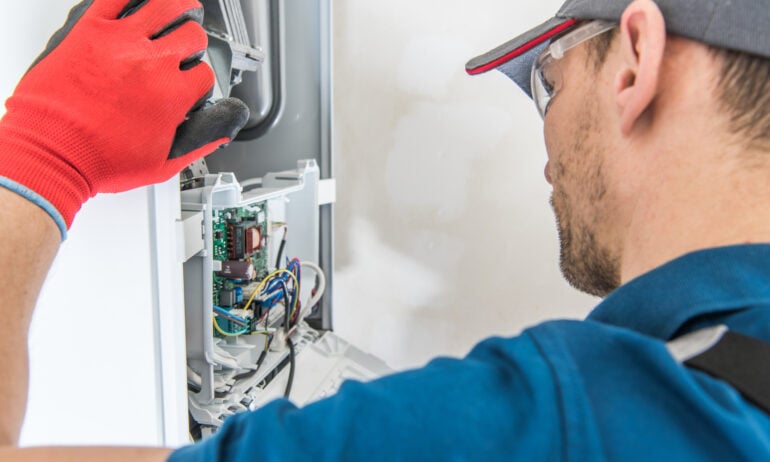How Much Does It Cost to Replace a Furnace in 2025?
The cost to replace a furnace depends on your home size, unit type, and your existing furnace and ductwork.

Some or all of the mortgage lenders featured on our site are advertising partners of NerdWallet, but this does not influence our evaluations, lender star ratings or the order in which lenders are listed on the page. Our opinions are our own. Here is a list of our partners.
The cost to replace a furnace is about $4,800 on average, but the price can range from around $2,800 to $6,800, according to home services website Angi. Your total cost will include the price of the furnace and labor for installation, plus permits and duct installation or removal if needed.
Factors that affect the overall cost of furnace replacement include the furnace type and heating capacity for your home size. The age of your existing furnace and ductwork can also affect the final bill. Furnaces last around 20 years on average, and older ductwork may not be compatible with a new unit.
Furnace cost by type
Furnaces come in five main types, with different cost ranges and features. Here are your options:
Type | Price range | Things to know |
|---|---|---|
Electric | $2,000 to $7,000. | Low maintenance with a low installation cost, but the highest monthly cost. |
Propane | $3,700 to $14,200. | Low monthly costs but high upfront costs. |
Natural gas | $3,800 to $10,000. | Most efficient and low-cost to run, but requires ductwork. |
Oil | $6,750 to $10,000. | Most eco-friendly, but oil can be expensive. |
Wood | $2,600 to $12,500. | Lower-cost and works off-grid, but less efficient and higher maintenance. |
Natural gas furnaces are the most common. More energy-efficient natural gas models can cost more upfront but save you money down the road.
Furnace cost by home size
Furnaces are available in different heating capacities, which are measured in British thermal units (BTUs). One BTU represents the amount of heat needed to raise the temperature of a pound of water by one degree Fahrenheit.
Your home will need a furnace with a capacity of about 30 to 60 BTUs per square foot, with homes in colder climates at the higher end of that range. You might also need a higher BTU capacity if your home is older or not well-insulated, your windows aren’t energy efficient, or your furnace isn’t energy efficient.
Here are some sample home sizes by square foot, the BTUs recommended to heat the home and the price range of a furnace with that capacity:
Home size | BTUs | Average cost |
|---|---|---|
1,000 square feet | 30,000 to 60,000. | $1,200 to $2,000. |
2,000 square feet | 60,000 to 120,000. | $2,400 to $4,000. |
3,000 square feet | 90,000 to 180,000. | $3,600 to $6,000. |
5,000 square feet | 150,000 to 300,000. | $6,000 to $10,000. |
Labor costs for furnace replacement
For a standard furnace installation, which can take four to 10 hours, expect labor costs of around $75 to $100 per hour. The following can increase labor costs:
Removing your existing furnace can cost an additional $60 to $330.
Installing new ductwork can cost about $2,000 to $5,000. Older ductwork may not be compatible with new furnaces. Replacement typically takes five to seven hours, and you can expect over half of the cost to be labor.
Getting a permit can cost $400 to $1,500 and may be required in some areas. Your furnace installer will obtain the necessary permits, and the cost may be included in your contractor’s quote.
HELOC & Home Equity Loans from our partners

on FourLeaf Federal Credit Union
670
$1,000,000
on FourLeaf Federal Credit Union
Signs you need to replace your furnace
Furnaces typically last 15 to 20 years, but some types can last up to 30 years with proper maintenance. Outdated furnaces are less energy efficient, which can increase your monthly energy costs, and may be more prone to dangerous carbon monoxide leaks.
Here are signs that it’s time to replace your furnace:
Your energy bills are increasing.
Your furnace is breaking down often and requires frequent repairs.
Your home, or certain rooms, aren’t heating.
Dust and soot are building up in your home.
The furnace is making strange sounds, including popping, screeching and rattling.
The furnace smells. A rotten egg smell is a sign that the furnace is producing carbon monoxide.
The flames are yellow instead of blue. This can be a sign the furnace is producing carbon monoxide.
Can I get financing for a home repair or improvement?
Your contractor may offer some financing options (either through a partner or a payment plan), but there are other — and maybe better — financing options available.
Which financing option is best for me?
The best financing option for you will depend on how much money you need, when you need the money, what project you’re doing and how long you need to pay the money back. If it’s something that’ll add value to your home, a HELOC or home equity loan may be your best option because the value of your house could increase by more than the amount of the loan.
On the flip side, if it’s a less expensive repair, a credit card is probably your best option if you want to pay no interest or earn rewards. Personal loans can apply to both small and large repairs or renovations, and they may make sense if you don’t have much equity in your home.
Some home improvement contractors offer their own financing options. Before taking this option, shop around and see how their offer compares with other loans.
Regardless of what you choose, make sure you compare interest rates, terms and fees with any financing options you’re considering. This will ensure you get the best deal.








